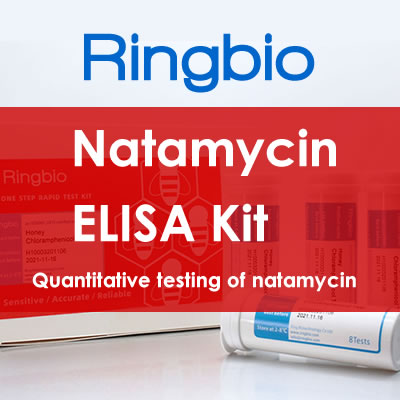November 20, Beijing - Ringbio is pleased to announce a new product, Natamycin ELISA Kit, a microtiter plate-based quantitative ELISA to detect natamycin in milk, cheese, brine, fermented milk, etc.
Background of natamycin
Natamycin has been used for decades in the food industry as a hurdle to fungal outgrowth in dairy products and other foods. Potential advantages for the usage of natamycin might include the replacement of traditional chemical preservatives, a neutral flavor impact, and less dependence on pH for efficacy, as is common with chemical preservatives. It can be applied in a variety of ways: as an aqueous suspension (such as mixed into a brine) sprayed on the product or into which the product is dipped, or in powdered form (along with an anticaking agent such as cellulose) sprinkled on or mixed into the product. However, in recent years, there are callings for controlling the use of natamycin in dairy products.
Throughout the European Union, natamycin is approved only as a surface preservative for certain cheese and dried sausage products. It must not be detectable 5 mm below the rind. While natamycin is approved in different applications at different levels in the world, it is approved in over 150 countries worldwide.
The European Food Safety Authority (EFSA) panel took over the responsibilities of providing scientific food safety advice to the EU from the Scientific Committee on Food in 2002. In 2009, the EFSA considered the proposed use levels of natamycin are safe if it is used for the surface treatment for these cheese and sausage types.
Regulations of Natamycin in cheese
Though it is approved as food additives, EU, USA, Canada, China, etc all set strict Maxium Levels for natamycin in cheese.
| Countries or regions | Maximum Levels of natamycin | Products |
|---|---|---|
| European Union | 1mg/dm2 | Semi-hard and semi-soft cheese and dry, cured sausage |
| USA | 20 mg/kg | Cheese |
| Canada | 20 mg/kg | Surface of cheese & cheddar cheese |
| Canada | 10 mg/kg | Surface of grated or shredded cheese & cheddar cheese |
Data from US FDA, Health Canada and EU EFSA websites.

Comparison od methodologies for detection of natamycin
| Method | Instrument | Sensitivity | Pros | Cons |
|
HPLC (ISO 9233-1:2018 Cheese, cheese rind and processed cheese) LC-MS |
HPLC, LC-MS | 500 ng/g, ng/mL |
|
|
| Natamycin ELISA Kit | ELISA reader | 2 ng/g, ng/mL |
|
|
| Natamycin Rapid Test Kit | No instrument | 5-6 ng/g, ng/mL |
|
|
From the table above, conclusions can be drawn that Natamycin ELISA Kit and Natamycin Rapid Test Kit are more suitable for small manufacturers such as cheese makers, dairy companies, dairy farms, etc to control the natamycin concentration in their products, while HPLC, LC-MS, shall be applied by third-party labs.
References
- Natamycin topic page, Wikipedia
- Radicevic, T., et al. "Determination of natamycin (food additive in cheese production) by liquid chromatography-electrospray tandem mass spectrometry." IOP Conference Series: Earth and Environmental Science. Vol. 333. No. 1. IOP Publishing, 2019.




